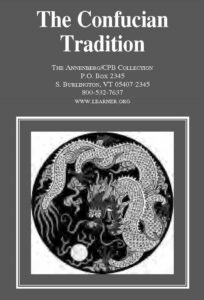This video on The Confucian Tradition is part of the Columbia University project on Asia in the Core Curriculum of Colleges and Schools. The video production was funded by the Annenberg/CPB Project, the Henry Luce Foundation, and the Department of Education.
 Students are introduced first to the concept of the Axial Age and its “100 Schools of Thought.” Confucianism is skillfully tied to other world intellectual traditions, and its divergences noted straightway. The important differences between Indian and Confucian epistemology are highlighted, and viewers are prepared for what follows as distinctively Chinese. The point here is to create in the viewer a sense of global connection without overstating dependencies of streams of thought on one another.
Students are introduced first to the concept of the Axial Age and its “100 Schools of Thought.” Confucianism is skillfully tied to other world intellectual traditions, and its divergences noted straightway. The important differences between Indian and Confucian epistemology are highlighted, and viewers are prepared for what follows as distinctively Chinese. The point here is to create in the viewer a sense of global connection without overstating dependencies of streams of thought on one another.
Once the Confucian tradition is contextualized, the narrative focuses quickly on that tradition specifically. Several fine scholars offer contributions, the foremost of which is Theodore de Bary. The text considers in what senses Confucianism may be characterized as a religion, and in what ways this model does violence to an informed understanding of the tradition. The interesting features of ancestor tablets and grave rituals are presented, and their tie to the broader tradition is examined.
Professors can be confident that viewers of this video will be introduced to the central concepts of Confucianism. Filial piety, jen, self-cultivation, the mandate of heaven, reciprocity, junzi, ritual (li), and the examination system are among those notions which are well defined. Jen is rightly portrayed as the ultimate goal of the Confucian tradition. I am not sure, though, if we should excuse the speakers for still using the English, “gentleman” for junzi.
A strength of the production is its use of the classical texts. These are read in Chinese and translated for the viewer. The chosen texts are important ones and they are well-selected examples of the concepts they are meant to illustrate. The visual and auditory symbiosis of the presentation is appealing.
Another reason for using this video as an introduction to the Confucian tradition is that it does a commendable job of moving the conversation along to Mencius and then to Neo-Confucianism. Attention is given to Mencius’s contribution to an understanding of the five basic relationships and to his own construction of the three fundamental values of ritual, humanness, and filial piety. The Neo-Confucian emphasis on self-cultivation, together with its interest in metaphysics and epistemology, are shown to be direct responses to the influence and prominence of Buddhism in the Chinese culture.
The video is not merely descriptive. The scholars represented also make claims which an instructor can use to push into deeper waters. Myron Cohen, for example, observes that the moral fabric of relationships seen in filiality is understood in Confucianism “to be as much a part of the order of the cosmos as is the sun rising each morning.” Filial piety is not a human invention. Morality is not subjective, but neither is it a result of divine command. Here we have one of the more controversial of Confucian notions—a morally ordered naturalism. (I deliberately do not say “natural law.”)
Another claim worthy of further conversation is that the mandate of heaven was transformed from a political concept to one applicable principally to the individual personal life. The implications of this move are well worth considering.
The video makes clear in what senses the present regime is promulgating a new Confucianism. The way of humanness and the exemplary person is the product of education and self-cultivation, and this video makes its own contribution to both. Further information on the Annenberg/CPB collection may be obtained at: http://www.learner.org.

